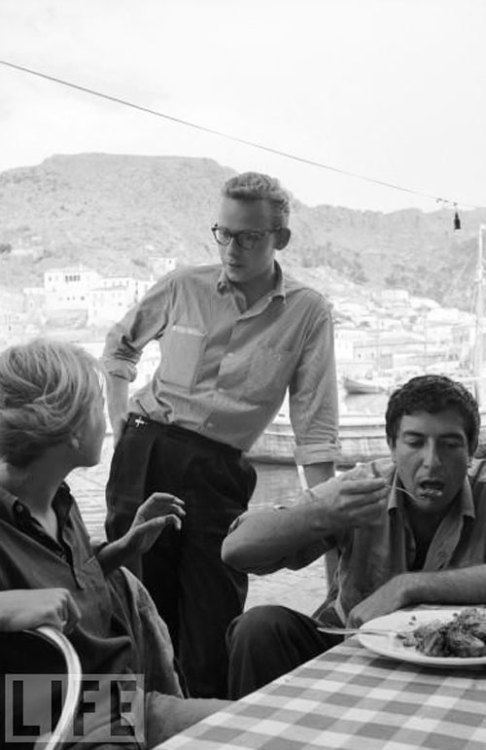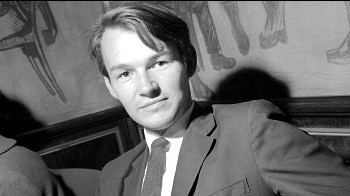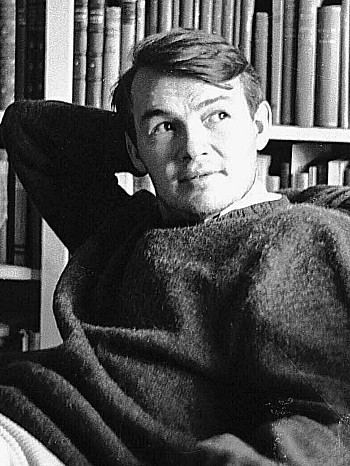Children Tale Naess Role Author | Name Axel Jensen Occupation Author Books Epp, Jumbo, Senior | |
 | ||
Full Name Axel Buchardt Jensen Died February 13, 2003, Alefjaer, Norway Spouse Pratibha Jensen (m. 1974), Marianne Jensen Similar People Olav Angell, Tale Naess, Trond Peter Sta | ||
Axel Jensen
Axel Buchardt Jensen (12 February 1932 – 13 February 2003) was a Norwegian author. From 1957 until 2002, he published both fiction and non-fiction texts which include novels, poems, essays, a biography, and manuscripts for cartoons and animated films.
Contents

1983 Axel Jensen om filmplaner
Biography

Jensen was born in Trondheim. He first made his debut as a novelist in Oslo in 1955 with the novel Dyretemmerens kors (1955), but he later burned the remaining unsold books.

In 1958 he and his then girlfriend, later wife, Marianne Ihlen, lived on the Greek island of Hydra, where Jensen developed a friendship with the Canadian musician and poet Leonard Cohen. Cohen and Marianne lived together on Hydra for a couple of years after the break-up between her and Jensen, and later moved to Montreal. There is widespread belief that the character Lorenzo in the novel Joacim (1961) is modeled after Cohen, but Jensen also told Cohen that Lorenzo was modeled after the Swedish novelist Göran Tunström.
After some time, Jensen returned to Norway and settled in Fredrikstad. There, Noel Cobb, an English poet and student of psychology, came to interview him. Cobb became sexually involved with Jensen's girlfriend Lena. Jensen then left Fredrikstad to live in London.
Jensen suffered from severe depression after the break-up with Lena, but in London, he met the psychiatrist R. D. Laing and received therapy from him. After recovering, Jensen worked as an assistant at the institution Kingsley Hall. Laing remained a close friend for the rest of his life.
While attending an environmental conference in Stockholm in 1972, Jensen met Pratibha, whom he married in India. After returning to Sweden, the couple lived in Vaxholm, outside Stockholm, where they bought an old freighter, built in 1905, which they renamed S/Y Shanti Devi. The ship was named after Pratibha's mother and means "The Goddess of Peace".
After restoring the ship with the help of good friends and its former crew, they finally set course for England in 1984. Unfortunately, due to a storm at sea, they were forced to seek harbor in Oslo after a short, hazardous journey.
When Jensen arrived in Oslo, he met his old friend, the writer Olav Angell. Together, they wanted to transform Oslo into a city renowned for happenings on the scene of international literature. The plan was soon put into action, and Jensen became the front figure in a project which later developed into the Oslo International Poetry Festival (OIPF), occurring in 1985 and 1986.
On 10 August 1990, Shanti Devi set course for what would be its final destination in Ålefjær, outside Kristiansand. There, Jensen and Pratibha settled in a hundred-year-old schoolhouse and, some years later, they sold their old ship.
In the last ten years of his life, Jensen was severely disabled from Amyotrophic lateral sclerosis (ALS). He gradually became paralyzed, losing all his motor-coordination abilities. Later, relying on a breathing-aid to breathe, he could neither write nor speak. During this period, he also led a tough campaign against what he termed "the health machinery" for the right to be nursed in his own home. Jensen wrote several essays and articles on this subject. Before the public health service provided the help he needed, private funding to pay for nursing was arranged by his close friends, including Leonard Cohen. His wife also used all of her available energy to nurse her husband until he drew his last breath in his home in Ålefjær.
In 1996, he received the Fritt Ord Honorary Award.
Writing style
Apart from his first symbolistic novel, Dyretemmerens Kors, Jensen's early novels mostly depict young men that attempt to break away from their social and cultural backgrounds. These novels include Icarus: A Young Man in Sahara (1957) (a new 1999 edition is illustrated by Frans Widerberg), A Girl I Knew (1959), and Joacim (1961). Some critics have argued that these early novels are influenced by Beat authors like Jack Kerouac, Allen Ginsberg, and William Burroughs. The reason for this is that the novel's male main characters often try to escape from their obligations in a Western capitalistic society. Instead, they try to replace their former life with some sort of undefined spiritualism and fail miserably in their attempt.
Later, Jensen departed from the realism in his early novels and began to move in a new direction by writing science fiction, poems, essays, and manuscripts for cartoons. In this experimental phase, he produced manuscripts for the psychedelic comic-strip Doctor Fantastic (published in the newspaper Dagbladet between March and July 1972), the science fiction comic strip collage Tago (1979), the animated movie Superfreak (1988), and a manuscript for a comic novel which is a caricature-rendering of the life of the French playwright and founder of pataphysics, Alfred Jarry. In the same period, Jensen also published a poem-collection with a hindu theme called Onalila – A Little East West poetry (1974), an essayistic novel called Mother India (1974), and three autobiographical novels named Junior (1978), Senior (1979), and Jumbo (1998).
Jensen is perhaps most famous for having written the science fiction novels Epp (1965), Lul (1992), and And the Rest is Written in the Stars (1995), illustrated by Pushwagner. With these novels, Jensen created a dystopian vision of the future, much in the tradition of Aldous Huxley, George Orwell, and Ray Bradbury. Nevertheless, Jensen's novels also differ from these authors since the tragic vision in his novels is supplemented with comedy, setting an ambiguous and absurd tone. In this way, Jensen's novels are similar to the satirical and parodic novels of Jonathan Swift and Kurt Vonnegut.
Besides his fiction, Jensen also published a series of articles and essays which focused on three main political and social issues. His collection of essays, God Does Not Read Novels. A Voyage in the World of Salman Rushdie (1994), is a critique of the fatwa against Salman Rushdie and a defense of freedom of speech. Another political text is the article A Children's Disease, published in the anthology The Collective Fairytale. A Book about Norway, Europe and the EU (1994). This article discusses Norway's role as a future member in the European Union. The third main issue that was of great concern to him was how sick and disabled people are treated in a modern bureaucratic society. Two books containing articles on this subject was therefore published – The Deafening Silence (1997) and The Patient in the Centre (1998). All the articles are an account of how it is to suffer from ALS and at the same time not receive adequate help from the Norwegian welfare state.
Among his political writings, Jensen also found the time to write a biography on G. I. Gurdjieff, titled Guru – Glimpses from the World of Gurdijieff (2002). In addition to this, Jensen co-wrote his autobiography, Life Seen From Nimbus (2002), with Peter Mæjlender.
Jensen received a literary prize from the Austrian Abraham Woursell Foundation in 1965 for his novel Epp. In 1992, Jensen was given the annual literary award from the Norwegian publishing house Cappelen for his novel Lul. For his essays on Salman Rushdie, he received the Carl von Ossietzky award from the International PEN club in 1994 and an award from The Freedom of Expression Foundation in Norway.
